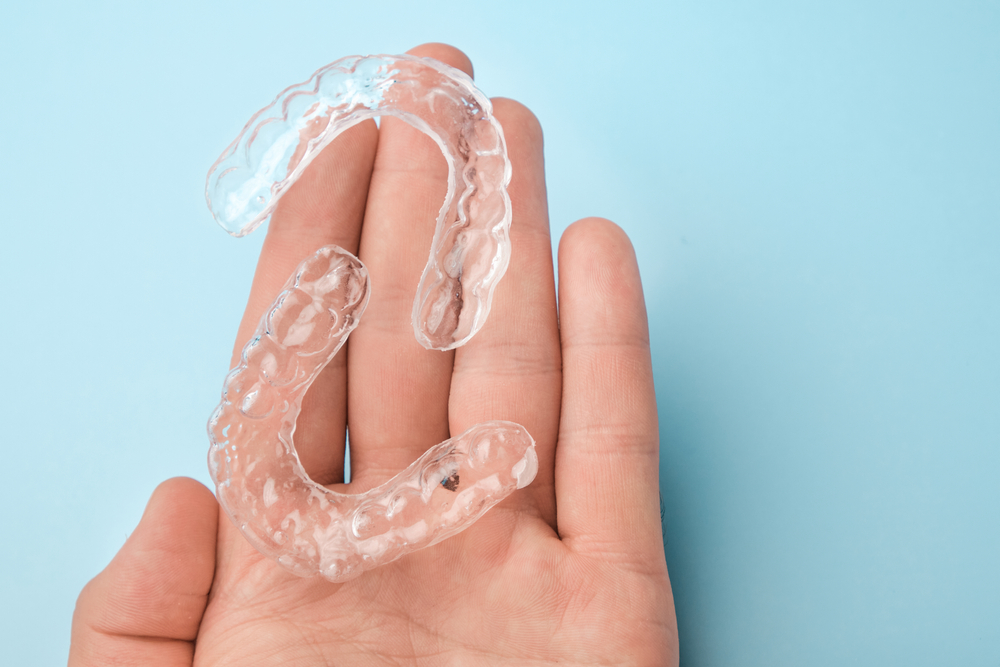Those looked for a more conventional, better aligned smile no longer need rely on wire and metal braces. Teeth aligners – easily procured from dentists’ offices – offer a number of at-home treatments.

Aside from the obvious benefit of being nigh-invisible, teeth aligners are much more affordable, comfortable and convenient in comparison with traditional braces. What’s more, some evidence suggests that they are actually quicker to work than regular braces[1].
Teeth Aligners – What Are They?
Teeth aligners are transparent orthodontic accessories that work to realign teeth without using the brackets or wires that are found in conventional braces, according to William Busch DMD – a dentist who directs North Kansas City Dental (Kansas City, MO).
Busch states that, rather than the traditional mono-directional force applied in conventional braces, a teeth aligner works to realign teeth from three separate directions. This extra push to move the tooth into position makes teeth aligners approximately 20% faster than regular braces, claims Busch.
Do Teeth Aligners Work?
The evidence would suggest so. Research indicates that transparent teeth aligners (also called “invisible braces”) are just as effective as conventional braces in realigning teeth – the only difference between the two is the amount of time required to achieve the same results.
Simply put: clear teeth aligners generally require less treatment time, but may not retain as effectively as conventional braces (especially without the use of a retainer). That said, the AAO (American Association of Orthodontics) asserts that there is no one correct method when it comes to orthodontic treatment; each case must be approached individually. Before braces or aligners of any kind are used, it’s important to seek diagnosis from a professional orthodontist.
What Are The Benefits Of ‘Invisible Braces’?
Clear teeth aligners typically confer several benefits according to Payam C. Ataii DMD, a dentist who practices at Laser Dental Center, Laguna Hills, CA. Ataii says that invisible braces are provably faster and more efficient than conventional braces, with treatment times as low as 4-8 months.
A less obvious – but equally important – benefit of transparent aligner use is better oral hygiene. Ataii says that regular braces hinder the wearer in normally simple tasks such as brushing your teeth. Teeth aligners, conversely, can be removed and set aside while the wearer brushes and flosses their teeth, making these basic acts of oral hygiene much simpler and more efficient.
This ability to remove a teeth aligner means that certain foods are back on the menu, too. Patricia J. Panucci, DMD, who runs Beach Braces in Manhattan Beach, CA, says that with teeth aligners you’re able to eat food that traditional braces would prevent – namely hard, brittle or chewy foods.
But these benefits aside, continues Panucci, possibly the strongest argument in favor of clear teeth aligners is how discreet and convenient they are. Not only is it possible to attain a better smile with a minimum of dental intervention, but it’s possible to do so without obtrusive and obvious metal braces.
How Much Are Clear Teeth Aligners?
Invisible-brace brands such as Invisalign typically cost between $1800-$9500 without insurance; exactly how much depends on the needs of the individual patient and the length of the treatment period. Per GoodRX (a healthcare and pharmaceutical price comparison service), the average cost for a teenager is roughly $3000. Contrast this with conventional metal brace treatment, which usually cost between $3000-$7000.
It’s possible that the cost of aligners such as Invisalign will be covered by dental insurance providers. However, some may classify the treatment as ‘cosmetic’, and in this instance it would not be covered. It’s always worth checking with your insurance provider first to find out what is and is not covered.
What Are The Risks Of Teeth Aligners?
While the above benefits undoubtedly make teeth aligners a very appealing option, experts still insist that a visit to a dentist/orthodontist prior to treatment is paramount. The reason for this is that there may be undiagnosed dental issues that could preclude the use of teeth aligners. One such issue, for example, is the existence of untreated cavities; aligners restrict oxygen to the gums and teeth, making it easier for bacteria to proliferate in the area. Identifying and treating such cavities is therefore essential before the use of an aligner begins.
Panucci adds that there may be other drawbacks with teeth aligners. Getting an aligner is only half the battle; it must be used as prescribed for optimal effectiveness. Panucci herself tells her patients that the aligners are only good when they’re in, and not left to one side. Furthermore, she states that invisible braces are not appropriate for everyone; it’s therefore important that anybody considering them first consult with a professional to make the best informed decision.
Busch states that the patients most suited for at-home aligner use are those with minor crowding whose teeth need a small tweak. Those for whom aligners are not suitable, according to Panucci, are patients with misaligned jaws – invisible braces cannot help with this issue – and those with underlying tissue problems (for instance, gingiva and bone issues). For orthodontic issues of such severity, treatment must be prescribed and monitored by dental professionals to ensure the situation is not exacerbated.
Things To Consider When Purchasing Teeth Aligners
Victoria Veytsman DDS, a cosmetic dentist out of Cosmetic Dental Studios in Beverly Hills, CA and New York City, NY, says that the health of your teeth and gums are extremely important prior to treatment. Any history of gum disease or inconsistent oral hygiene can mean that teeth aligners are not suitable. Further, asserts Veytsman, some misalignments can be complex, and necessitate more in-depth treatment than aligners can offer. Veytsman stresses that there is no single approach to something as complex as orthodontics.
That said, those with spacing problems or minor/moderate crowding will find clear teeth aligners a favorable option. Before settling on a treatment plan, it’s worth considering the following:
- Expense. It’s important that patients exercise due diligence and research costs before making any final decisions, says Ataii. Costs can vary, starting at $1500 and sometimes going north of $3000. Ataii states that it’s therefore important that patients go with the option that is the best fit for both their budgets and orthodontic requirements.
- Convenience. Ataii adds that there are several ways to approach treatment with invisible braces. While some practices can only mail prescribed impression kits to you at home, others will offer onsite consultations at their surgeries. He also notes that there are companies able to do both, such as SmileDirectClub. Such companies generally offer a face-to-face consultation with a dentist to kick off your treatment.
- Treatment time. Ataii stresses the importance of following your dentist’s prescribed treatment plan, and of ensuring the aligner is kept in your mouth for the recommended amount of time. The reason for this, he says, is that your dentist has carefully calculated the pressure applied to each one of your teeth – and the amount of time that pressure needs to be applied. Part of that equation is how much time the aligner spends out of your mouth; if you deviate from that schedule, you may adversely affect your treatment time.
- Treatment options. Any aligner treatment course should be directed by a doctor, and an orthodontist and/or dentist licensed to practice in your state should be on hand throughout treatment and available for consultations throughout, according to Ataii. Additionally, the patient themselves should research the issue thoroughly before embarking upon an aligner treatment plan, in order to ensure that they’re making the right choice for their dental health and budget.
It’s imperative with at-home aligner courses that you first consult with an orthodontist and meticulously follow any prescribed treatment plan, asserts Panucci; any deviation may mean that your treatment is ineffective – or, worse, actively unsafe.
Regular check-ins are also important as your teeth/bite start to shift. Many aligner options include both 22-hour daily wear, and overnight only. You may well have a preference for one over the other, says Ataii, but ultimately it’s up to a doctor to determine which you’re viable for.






